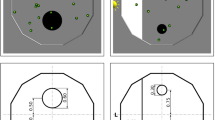Abstract
Robot software developed in simulation often does not behave as expected when deployed because the simulation does not sufficiently represent reality—this is sometimes called the ‘reality gap’ problem. We propose a novel algorithm to address the reality gap by injecting real-world experience into the simulation. It is assumed that the robot program (control policy) is developed using simulation, but subsequently deployed on a real system, and that the program includes a performance objective monitor procedure with scalar output. The proposed approach collects simulation and real world observations and builds conditional probability functions. These are used to generate paired roll-outs to identify points of divergence in simulation and real behavior. From these, state-space kernels are generated that, when integrated with the original simulation, coerce the simulation into behaving more like observed reality. Performance results are presented for a long-term deployment of an autonomous delivery vehicle example.
The views and conclusions contained herein are those of the authors and should not be interpreted as necessarily representing the official policies or endorsements, either expressed or implied, of the U.S. Department of Defense or the U.S. Government. Lyons was partially supported by DL-47359-15016 from Bloomberg LP.
Access this chapter
Tax calculation will be finalised at checkout
Purchases are for personal use only
Similar content being viewed by others
References
Reckhous, M., Hochgeschwender, N., Paulus, J., Shakhimardanov, S., Kraetzschmar, G.: An overview about simulation and emulation in robotics. In: International Conference on Simulation, Modeling & Programming for Autonomous Robots, pp. 365–374 (2010)
Peng, X.B., Andrychowicz, M., Zaremba, W., Abbeel, P.: Sim-to-real transfer of robotic control with dynamics randomization. In: IEEE International Conference on Robotics and Automation (2018)
Moeckel, R., Perov, Y., Nguyen, A., Vespignani, M., Bonardi, S., Pouya, S., Sproewitz, A., van den Kieboom, J., Wilhelm, F., Ijspeert, A.: Gait optimization for roombots modular robots–matching simulation and reality. In: IEEE/RSJ International Conference on Intelligent Robots and System (2013)
Hofer, S.E.A.: Perspectives on Sim2Real Transfer for Robotics: A Summary of the RSS 2020 Workshop (2020). arXiv:2012.03806 [cs.RO]
Takayama, Y., Ratsamee, P., Mashita, T.: Reduced simulation: real-to-sim approach toward collision detection in narrowly confined environments. Robotics 10(131) (2021)
Tobin, J.M., Zaremba, W., Abbeel, P.: Domain randomization and generative models for robotic grasping. In: IEEE/RSJ International Conference on Intelligent Robots and System (2017)
Dehban, A., Borrego, J., Figueiredo, R., Moreno, P., Bernardino, A., Santos-Victor, J.: The impact of domain randomization on object detection: a case study on parametric shapes and synthetic textures. In: IEEE/RSJ International Conference on Intelligent Robots and System, pp. 2593–2600 (2019)
Ljung, L.: Perspectives on system identification. In: 17th IFAC World Congress, vol. 41, no. 2 (2008)
Verdult, V., Ljung, L., Verhaegen, M.: Identification of composite local linear state-space models using a projected gradient search. Int. J. Cont. 75, 16–17 (2001)
Benjamin, P., Lyons, D., Funk, C.: A cognitive approach to vision for a mobile robot. In: SPIE Multisensor. Multisource Inf, Fusion (2013)
Lyons, D., Nirmal, P.: Navigation of uncertain terrain by fusion of information from real and synthetic imagery. In: SPIE Multisensor. Multisource Inf, Fusion (2012)
Christiano, P., Shah, Z., Mordatch, I., Schneider, J., Blackwell, T., Tobin, J., Abbeel, P., Zaremba, W.: Transfer from Simulation to Real World Through Learning Deep Inverse Dynamics Model. arXiv 1610.03518 (2016)
Yu, W., Kumar, V.C., Turk, G., Liu, C.K.: Sim-to-real transfer for biped locomotion. In: IEEE/RSJ International Conference on Intelligent Robots and System (2019)
Saputra, R.P., Rakicevic, N., Kormushev, P.: Sim-to-real learning for casualty detection from ground projected point cloud data. In: IEEE/RSJ International Conference on Robotics and System (2019)
Chebotar, Y., Handa, A., Makoviychuk, V., Macklin, M., Issac, J., Ratliff, N., Fox, D.: Closing the sim-to-real loop: adapting simulation randomization with real world experience. In: IEEE International Conference on Robotics and Automation (2019)
Bartocci, E., Falcone, Y.: Lecture Notes in Computer Science. In: Lectures on Runtime Verification. LNCS, vol. 10457. Springer, Cham. https://doi.org/10.1007/978-3-319-75632-5
Adafruit lsm9ds1 imu (2020). www.adafruit.com/product/3387
Wang, R., Lehman, J., Clune, J., Stanley, K.O.: Paired Open-Ended Trailblazer (Poet): Endlessly Generating Increasingly Complex and Diverse Learning Environments and Their Solutions (2019). ArXiv, abs/1901.01753
Author information
Authors and Affiliations
Corresponding author
Editor information
Editors and Affiliations
Rights and permissions
Copyright information
© 2023 The Author(s), under exclusive license to Springer Nature Switzerland AG
About this paper
Cite this paper
Lyons, D.M., Finocchiaro, J., Novitzky, M., Korpela, C. (2023). A Monte Carlo Framework for Incremental Improvement of Simulation Fidelity. In: Petrovic, I., Menegatti, E., Marković, I. (eds) Intelligent Autonomous Systems 17. IAS 2022. Lecture Notes in Networks and Systems, vol 577. Springer, Cham. https://doi.org/10.1007/978-3-031-22216-0_40
Download citation
DOI: https://doi.org/10.1007/978-3-031-22216-0_40
Published:
Publisher Name: Springer, Cham
Print ISBN: 978-3-031-22215-3
Online ISBN: 978-3-031-22216-0
eBook Packages: Intelligent Technologies and RoboticsIntelligent Technologies and Robotics (R0)




